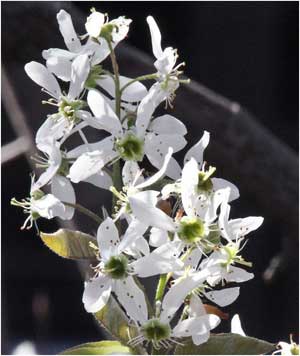Yes, they’re beautiful, but conservation experts are now asking you not to plant the old Kansas City standby, the Bradford pear tree.
The Missouri Department of Conservation says the trees are popular because they produce white flowers in the spring and are hardy. “Experts formerly considered them safe,” the department says in a press release. “Because they are hybrids, it was believed they could not produce viable seed.”
But experts have changed their minds. They are now cautioning against Bradford pears because they can become invasive and choke out native species in natural areas and parks.
The conservation department says the problem comes because a varied mix of cultivars allowed some Bradford pears to cross pollinate and produce viable seed. Wildlife such as birds eat the fruits and scatter seeds, spreading the trees. Bradford pears compete well against native plants and trees because they leaf out early.
“It’s also not a good ornamental tree because they’re not strong,” said Wendy Sangster, an urban forester for Missouri Department of Conservation (MDC). “They don’t stand up well in storms and the limbs break easily.”
What to do instead
Here’s the advice from the department of conservation:
- Gardeners and homeowners are urged to consider native alternatives for spring planting, such as the downy serviceberry, a native tree that produces a small red fruit edible for people and wildlife. The trees also produce showy white blooms in April and make good landscape additions.
- Another reliable and always showy native is the redbud tree. They’re quick growing with lovely lavender early-spring flowers and shapely green summer foliage.
- Wild plum is another good alternative tree that provides showy white blooms in spring.
- Dogwood trees will grow and bloom in Kansas City if planted in shady areas.
More information
- Butterflies and birds like native wildflowers and trees in landscape settings. They utilize the flowers, fruits and sheltering branches.
- More information about trees.
- Heartland Tree Alliance offers information specific to the Kansas City area.




It’s not just ‘Bradford’ pear. All varieties of ornamental pear contribute to this problem, including ‘Chanticleer’, ‘Cleveland Select’, ‘Aristocrat’ and any other variety of Pyrus calleryana. They’re all cross-pollinating each other and producing viable seed, popping up all over our natural areas and gardens. Yet our area garden centers still sell them and landscape designers and architects still include them in plans. Let’s shift that demand to the native alternatives mentioned in the article.
http://www.missouribotanicalgarden.org/PlantFinder/PlantFinderDetails.aspx?kempercode=a720
http://www.missouribotanicalgarden.org/PlantFinder/PlantFinderDetails.aspx?kempercode=c133
Everything wrote made a great deal of sense. However, think about this,
suppose you added a little information? I
am not saying your information is not solid., but what if you
added something to maybe grab people’s attention? I mean Experts ask you not to plant invasive Bradford
Pear trees – Midtown KC Post | Midtown KC Post is a little vanilla.
You should glance at Yahoo’s home page and see how they write article
titles to grab people interested. You might try adding a
video or a related pic or two to grab readers excited about everything’ve
written. Just my opinion, it could make your posts a little
livelier.